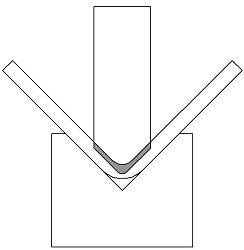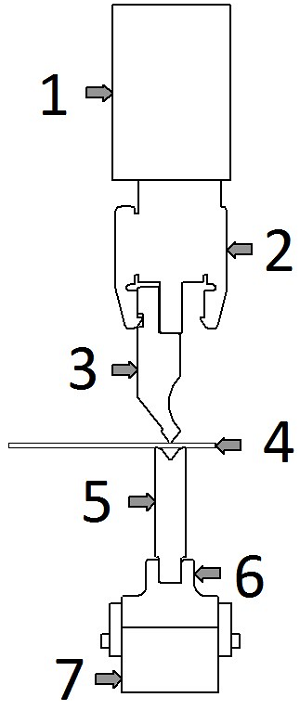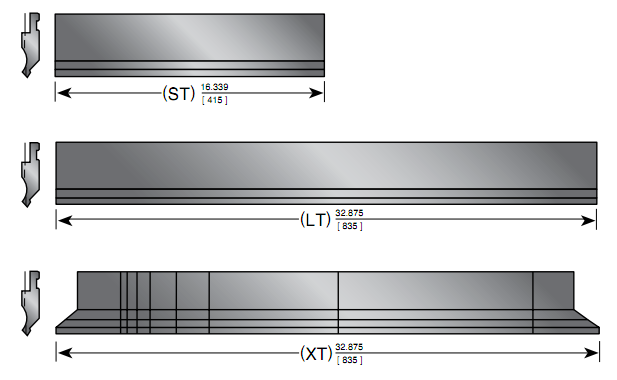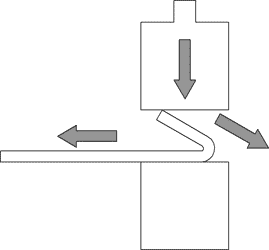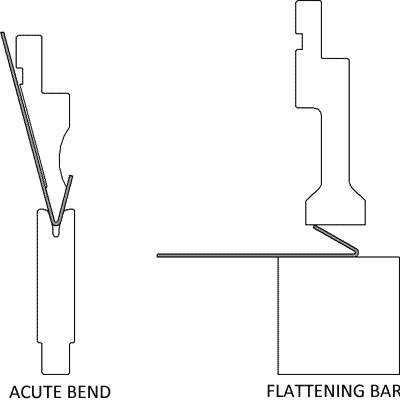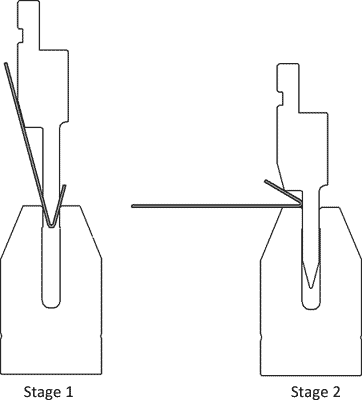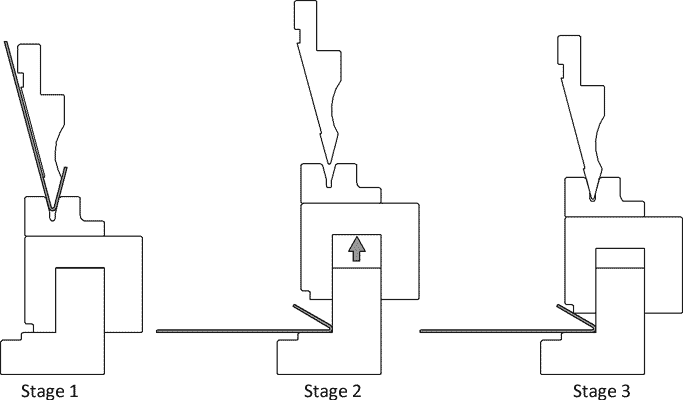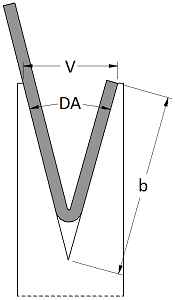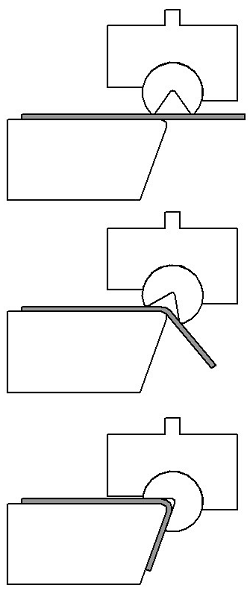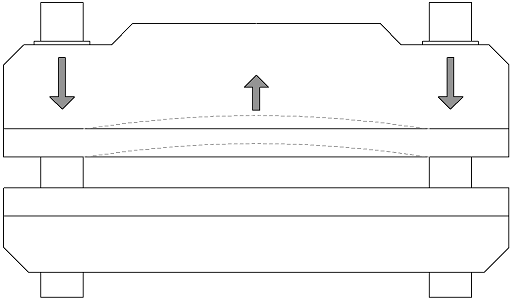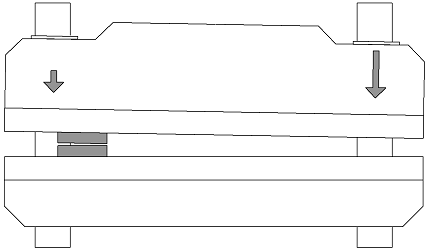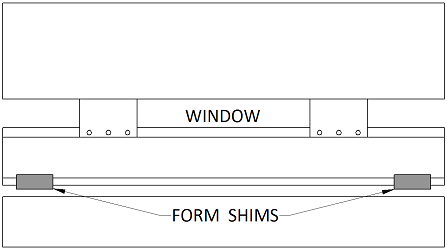1 – Upper Beam
The
upper beam is an integral part of the press brake and features a kind
of rail which the punch holder will mount to. On down acting brakes
this is the part of the machine that moves, transferring power to the
work piece.
4 – Punch Holder
The
punch holder attaches semi-permanently to the upper beam and serves to
hold a variety of punches. They come in two basic forms, European and
American, understanding the difference is important. See our post on European Vs. American Style Tooling for more information. Punch holders will typically have a built in shimming mechanism for balancing them with the lower die.
3 – Punch
Punches
are the upper part of the tooling system and are classified by their
Tip Angle, Relief Shape and their Installed Height. Standard Tip Angles
are 30 °, 45 °, 60 °, 75 °, 88 ° and 90 °. The 30 ° and 45 ° types are
known as acute punches. 60 ° and 75 ° Punches are used for Air Bending. 88 ° and 90 ° Punches are used for Bottom Bending. 90 ° Punches will be used for Coining. The relief shape allows for return bends to fold into the punch area.
The
installed height of press brake tooling is the distance from the tip of
the punch to where it contacts the upper beam / holder. For European
Tooling there are 7 standard heights. 65mm, 67mm, 70mm, 90mm, 95mm,
104mm, and 105mm.
Punches come in two styles when connecting to
the upper holder, European Style and American Style. European Tooling
has an offset holder (as shown above) where American Tooling has an
inline holder. Check our post on tooling styles for more information.
When
bending deep boxes which have long flanges around a base tab you’ll
want to investigate different tooling options. Some are basic such as
extending the punch holder and some are a bit mroe creative such as
window bending and 30-60 bending. For more information look into this
post on Box Bending.
4 – Work Piece
Commonly
referred to as the work piece the sheet metal being bent is the driving
force for all tooling selection. The type of material, its mechanical
properties and the intended bends drive all other aspects of the
tooling set up. Sheet metal is classified by it’s material and its
gauge. The gauge is a numerical value assigned to the thickness of the
metal. See our Gauge Chart for a better understanding of gauges and tolerances.
5 – Die
The
bottom section of the tooling is known as a die. Dies are classified
by the shape of the groove, the number of grooves and the height of the
die. The most common shape of die is a v die, which, as its name
suggests, is a block of tooling steel which has a v shaped groove cut
into it. A v die with a single groove is known as a 1V Die, dies with
two grooves are known as 2V Dies and so on. 2V Dies will always feature
the same angle on both grooves to prevent accidental damage, however
the v opening size will typically be different. This allows an
operator to quickly switch from bending a light gauge to bending a
heavy gauge without having to retrieve a new die. Second to v dies the
most common type is a U Die. U dies feature a rectangular cutout with
45 ° chamfered edges and flat tops. Because of this geometry U Dies
lend themselves to having grooves cut into more than one side of the
die. It’s not uncommon to see a 3U Die. There is much more information
on 3 sided dies here.
6 – Rail
The
rail is a manufactured piece of tooling which is attached to the press
brake and holds various dies. The rail typically features a protrusion
or groove which matches with the die set. This piece of tooling allows
you to level and straighten a single piece of tooling and then
interchange dies with confidence.
7 – Lower Beam / Die Holder
The
lower beam is part of the actual press brake which features a kind of
vice clamp for holding the raid or die set. On up acting brakes the
lower beam is moves upward to bend the metal. When inspecting and
maintaining your brake it is crucial to make sure the lower beam is
clean and level in relation to the punch holder.
Basic Requirements
First
the tooling should be of a size and weight which allows for handling,
installation and removal. Unless you have a fully automated system
there will be an operator responsible for setting up the Brake Press,
taking this into account is important to selecting your tooling. Second
to the safety of the operator is the accuracy of the tooling geometry.
Variance in the tooling geometry will directly contribute to under or
over bending of the work piece, or in extreme cases the damaging of the
tooling. Due to the high tonnages involved in bending any
imperfections on the surface of the punch or die can transfer to the
workpiece. Third the tooling should have excellent strength and wear
resistance. Typically heat treatment is applied to all Brake Press
tooling, greatly improving its hardness, strength and subsequently its
resistance to fatigue. Finally your tooling should be interchangeable
between your machines. There are two basic types of tooling for Brake
Presses, American and European, consider which type of machinery and
holders you have before purchasing new tooling.
Tooling Strength
During
the bending process the tooling will undergo both compressive forces
and bending moments. The repetitive nature of bending operations the
necessity for high strength and wear resistance demands quality steel
properly heat treated. When heat treating steel there are two methods,
hardening and thermal refining. To be referred to as tooling the piece
should be treated by one of these methods. Strictly speaking punches
and dies made from raw, untreated, metal should not be referred to as
tooling because it will not be effective when bending.
Hardened Tooling:
Two
common steels used for Brake Press tooling are Chromium Molybdenum
Steel, Type 4 (SCM4) and Yasuki Steel. Chromium Molybdenum Steel is a
structural steel used in aircraft parts, weapon components, roll cages
and structural car parts in addition to their use in tooling. The steel
is used for Brake Press tooling because of its receptiveness to heat
treatment. Typically this steel will obtain a HRC of 43 to 48 when
treated for tooling. Yasuki Steel is a product of the Japanese company
Hitachi and is made from very high quality iron sand. It has one of
the highest purities in commercial steel and is used in knives in
addition to tooling. Like SCM4 Yasuki Steel is very receptive to
hardening by heat treatment. Surface treatments like Wilson Tool’s
Nitrix Coating can bring the surface hardness of tooling to HRC 70,
further preventing wear of the tool’s geometry.
The manufacturing
process of hardened steel tooling is typically a 4 step operation;
Forming, Hardening, Correcting and Finishing. First the tool profile
is created from the stock material. Extra material is left on to be
removed later. The majority of the machining and forming is before the
hardening stage because after the tool has been hardened it will be
difficult to work with. The tooling is then hardened. Because of the
high heat the hardening process the tool will not finish with the
exact profile as before hand so additional correcting is done before
the tool is finished. The tool’s critical areas such as the punch tip
and v-opening are then ground by precision grinders, typically using
diamond or CBN coatings. On a die with a multiple v-opening the
different v’s are often ground together from one wheel.
Thermally Refined Tooling:
Steel
used for thermally refined tooling is typical a Carbon Steel, S45C. The
refining process unifies the internal structure of the steel
increasing its strength and hardness. Thermally refined tooling will
not be as hard as hardened tooling, typically only reaching HRC 23-28.
Thermally refined tooling is typically used for large or complicated
pieces. The larger pieces are more difficult to harden due to oven and
grinder size restrictions so thermal refining can be preferable. Small
or complicated pieces lend themselves to this method in order to
eliminate expensive correcting operations.
The manufacturing
process of thermally refined steel varies for the large and small
pieces. Large pieces follow similar steps as hardened tooling.
Unrefined metal is Formed, Refined, Corrected and Finished. For small
tooling the already Refined Material is Formed and Finished. Generally
speaking the reason for the different processes is because refined
stock is not available in large pieces due to a property called the
mass effect. The mass effect means that the inside of a large piece of
metal will not experience the same refining as the outside of the same
piece of stock. This is because the inside and outside of the material
cool at different speeds, resulting in different properties. When you
machine away the outer section of a large piece of refined stock
you risk exposing the inner section which was not treated in the same
manor as the outside. Its because of this that it is recommended
that large tooling be refined after the initial forming.
Handling & Installation
One
of the most important considerations of tooling geometry is the actual
size of the tool. Tools will be routinely moved, mounted, aligned,
removed and stored in a typical shop. To have a tool section which
requires multiple operators or machinery to load and unload is not
practical and should only be used if absolutely necessary. One piece
tooling is often cheaper then sectionalized tooling, and modern
manufacturing methods do provide adequate accuracy. It used to be the
case that limitations in grinder’s vertical accuracy per foot meant
that single long pieces of tooling would vary more from one end to the
other than that sectionalized tooling with an equal total length.
Today this is not a major factor when purchasing from a respectable
source.
Sectional tooling provides more than just easy handling, it also allows for more geometry options.
This
is a fairly standard break down of sectionalized tooling: 100mm Left
and Right Ear, 10mm, 15mm, 20mm, 40mm, 50mm, 200mm and 300mm. In
addition most manufacturers offer a 415mm ‘Short’ Section and a 835mm
‘Long’ Section. By combining different sections a wide variety of
possible lengths emerge.
